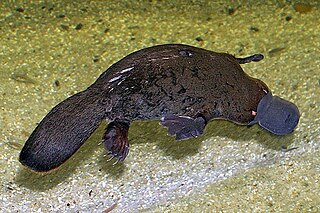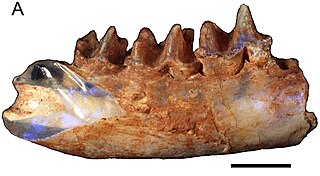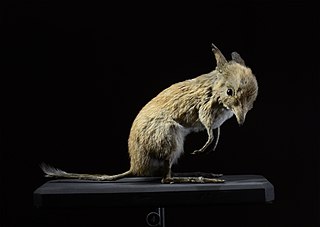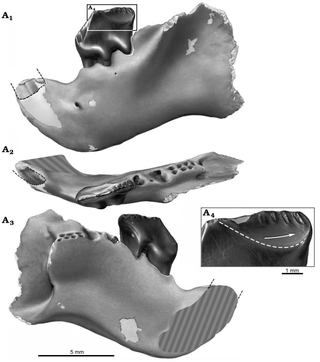
Echidnas, sometimes known as spiny anteaters, are quill-covered monotremes belonging to the family Tachyglossidae, living in Australia and New Guinea. The four extant species of echidnas and the platypus are the only living mammals that lay eggs and the only surviving members of the order Monotremata. The diet of some species consists of ants and termites, but they are not closely related to the American true anteaters or to hedgehogs. Their young are called puggles.

The Ornithorhynchidae are one of the two extant families in the order Monotremata, and contain the platypus and its extinct relatives. The other family is the Tachyglossidae, or echidnas.

Steropodon is a genus of prehistoric platypus-like monotreme, or egg-laying mammal. It contains a single species, Steropodon galmani, that lived about 100.2–96.6 million years ago during the Cretaceous period, from early to middle Cenomanian. It is one of the oldest monotremes discovered, and is one of the oldest Australian mammal discoveries. Several other monotremes are known from the Griman Creek Formation, including Dharragarra, Kollikodon, Opalios, Parvopalus, and Stirtodon.
Teinolophos is a prehistoric species of monotreme, or egg-laying mammal, from the Teinolophidae. It is known from four specimens, each consisting of a partial lower jawbone collected from the Wonthaggi Formation at Flat Rocks, Victoria, Australia. It lived during the late Barremian age of the Lower Cretaceous.

Phascolarctos is a genus of marsupials with one extant species, the koala Phascolarctos cinereus, an iconic animal of Australia. Several extinct species of the genus are known from fossil material, these were also large tree dwellers that browsed on Eucalyptus leaves.

Chaeropus, known as the pig-footed bandicoots, is a genus of small marsupials that became extinct during the 20th century. They were the only members of the family Chaeropodidae in order Peramelemorphia, with unusually thin legs, yet were able to move rapidly. Two recognised species inhabited dense vegetation on the arid and semiarid plains of Australia. The genus' distribution range was later reduced to an inland desert region, where it was last recorded in the 1950s; it is now presumed extinct.

Fulgurotherium is a dubious genus of ornithischian dinosaur from the Late Cretaceous (Cenomanian) Griman Creek Formation. It lived in what is now Australia.

The Australosphenida are a clade of mammals, containing mammals with tribosphenic molars, known from the Jurassic to Mid-Cretaceous of Gondwana. Although they have often been suggested to have acquired tribosphenic molars independently from those of Tribosphenida, this has been disputed. Fossils of australosphenidans have been found from the Jurassic of Madagascar and Argentina, and Cretaceous of Australia and Argentina. Monotremes have also been considered a part of this group in its original definition and in many subsequent studies, but its relationship with the relationship with other members has been disputed by some scholars.

Gould's long-eared bat is a microbat found in southern regions of Australia. It occurs in eastern Australia, from Queensland to Victoria, and in a smaller isolated range in the south-west of Western Australia.

The northern or sandy nail-tail wallaby is a species of macropod found across northern Australia on arid and sparsely wooded plains. The largest species of the genus Onychogalea, it is a solitary and nocturnal herbivorous browser that selects its food from a wide variety of grasses and succulent plant material. Distinguished by a slender and long-limbed form that resembles the typical and well known kangaroos, although their standing height is shorter, around half of one metre, and their weight is less than nine kilograms. As with some medium to large kangaroo species, such as Osphranter rufus, they have an unusual pentapedal motion at slow speeds by stiffening the tail for a fifth limb. When fleeing a disturbance, they hop rapidly with the tail curled back and repeatedly utter the sound "wuluhwuluh". Their exceptionally long tail has a broad fingernail-like protuberance beneath a dark crest of hair at its end, a peculiarity of the genus that is much broader than the other species. The name unguifera, meaning claw, is a reference to this extraordinary attribute, the purpose of which is unknown.

Neohelos is an extinct diprotodontid marsupial, that lived from the early to middle-Miocene. There are four species assigned to this genus, Neohelos tirarensis, the type species, N. stirtoni, N. solus and N. davidridei. N. davidridei is the most derived species of the genus, and its premolar morphology shows that it is structurally and ancestor of the genus Kolopsis. All four species are from the Bullock Creek in the Northern Territory and Riversleigh of Australia.

Glaucodon is an extinct genus of marsupial from Australia.

Monotremes are mammals of the order Monotremata. They are the only known group of living mammals that lay eggs, rather than bearing live young. The extant monotreme species are the platypus and the four species of echidnas. Monotremes are typified by structural differences in their brains, jaws, digestive tract, reproductive tract, and other body parts, compared to the more common mammalian types. Although they are different from almost all mammals in that they lay eggs, like all mammals, the female monotremes nurse their young with milk.
Ausktribosphenos is an extinct genus of mammals from Early Cretaceous of Australia. The only recorded species, Ausktribosphenos nyktos, was found on Flat Rocks, Victoria.

Corriebaatar is an extinct genus of multituberculate mammals. It contains the single species Corriebaatar marywaltersae and represents the first evidence of Australian multituberculates. It is known from fossils found in the Wonthaggi Formation date back to the Early Cretaceous.

Kryoryctes is a genus of prehistoric monotreme mammal from the Early Cretaceous (Albian) Eumeralla Formation of Victoria, Australia from the Otway Group of Dinosaur Cove. It is known only from a partial right humerus, estimated at 106 million years old, and contains one species, Kryoryctes cadburyi. The holotype, NMV P208094, was described in 2005 and is currently housed in the Museums Victoria Palaeontological Collection.

Yinotheria is a proposed basal subclass clade of crown mammals uniting the Shuotheriidae, an extinct group of mammals from the Jurassic of Eurasia, with Australosphenida, a group of mammals known from the Jurassic to Cretaceous of Gondwana, which possibly include living monotremes. Today, there are only five surviving species of monotremes which live in Australia and New Guinea, consisting of the platypus and four species of echidna. Fossils of yinotheres have been found in Britain, China, Russia, Madagascar and Argentina. Contrary to other known crown mammals, they retained postdentary bones as shown by the presence of a postdentary trough. The extant members (monotremes) developed the mammalian middle ear independently.

Diluvicursor is a genus of small ornithischian from the Lower Albian of Australia. It is known from one species, the type species D. pickeringi. The two known specimens, a vertebra and a partial juvenile postcranium discovered in 2005 from the Eumeralla Formation, are known, and they were named in early 2018.

Thomas H. Rich, generally known as Tom Rich, is an Australian palaeontologist. He and his wife, Patricia Arlene Vickers-Rich headed the dig at Dinosaur Cove. He is, as of 2019, Senior Curator of Vertebrate Palaeontology at Museums Victoria.
Teinolophidae is an extinct family of small mammals that are among the earliest known monotremes and were endemic to what would become Australia. Two genera have been described as belonging to this family: Teinolophos, and Stirtodon.





















